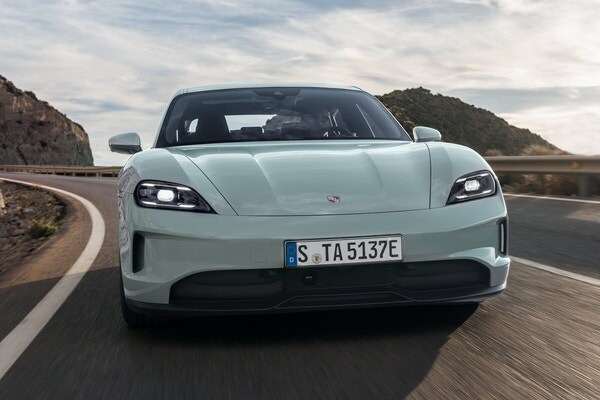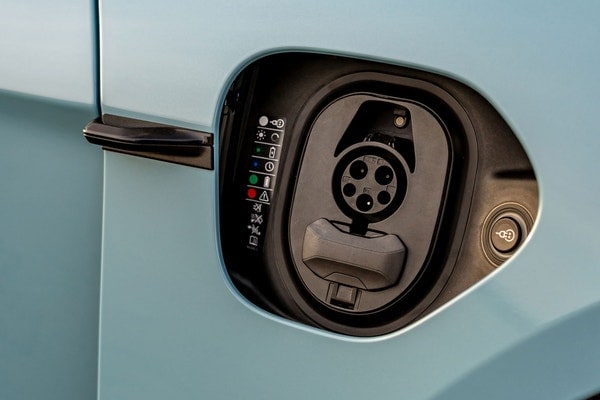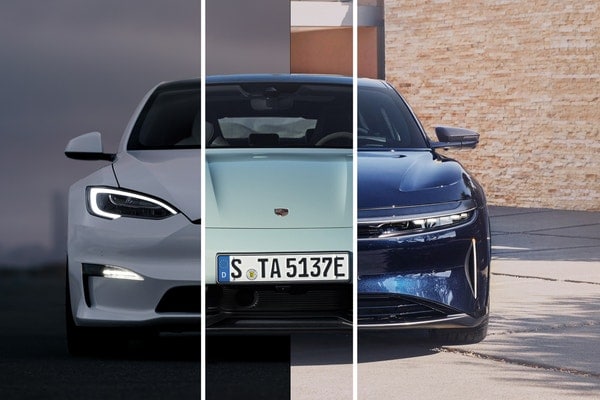Used 2012 Porsche 911 Carrera Black Edition Convertible Review
Consumer reviews
There are no consumer reviews for the 2012 Porsche 911 Carrera Black Edition Convertible.
Edmunds Summary Review of the 2012 Porsche 911 Carrera Black Edition Convertible
Pros & Cons
- Pro:Multiple models
- Pro:precise steering
- Pro:effortless acceleration
- Pro:powerful brakes
- Pro:all-wheel-drive option
- Pro:spacious cockpit
- Pro:surprisingly fuel-efficient
- Pro:highly customizable.
- Con:Option prices add up quickly.
Full Edmunds Review: 2012 Porsche 911 Convertible
What’s new
For the 2012 Porsche 911, there are actually two generations of the car on sale. An all-new Porsche 911 debuts and it's longer, wider, lighter and more powerful than before. Initially, this new car will be offered only as a coupe in Carrera and Carrera S trims. Meanwhile, the previous-generation 911 continues to be sold, and it carries over from last year without any significant changes and in a variety of different forms.
Edmunds says
With a new 2012 Porsche 911 entering the mix this year, the definitive sports car continues to improve. With so many variants available, there's probably one that fits your needs.
Vehicle overview
While most cars are redesigned every now and then, there is one that evolves slowly over time. This is the Porsche 911, an iconic sports car with a shape that is as recognizable today as when the model was first introduced in 1963. And for the 2012 Porsche 911, you have the chance to actually see the process of evolution in action, because an all-new 991 car is being introduced even as the previous-generation car continues to be sold.
Porsche will be selling this new 911 alongside the "old" 911, so no doubt there will be quite a bit of confusion from a shopping standpoint about the 2012 Porsche 911. To help clarify the two, we'll refer to them here using Porsche's technical code names for each platform: "991" for the new car and "997" for the old one. Initially, the new-generation 991 will only include the Carrera and Carrera S models in coupe body styles. The models of the previous-generation 997 will continue to be sold until their specific 991-type replacements come to market.
From the outside, the more notable changes for the 991 include larger oval headlights, pronounced flares for the wheel arches and slimmer LED taillights. Inside the cabin, you'll find some styling cues from the Carrera GT supercar and Panamera sedan, notably a new center console that extends to the dash and places the gear selector closer to the steering wheel. In the back, where all Porsche 911 engines reside, the Carrera S sports a 350-horsepower 3.4-liter flat-6 engine, while the Carrera S gets a 400-hp 3.8-liter. Either can be had with a new seven-speed manual or dual-clutch automated manual transmission. Other changes for the new 911 include electric-assist power steering and updated suspension designs for improvements in handling and comfort.
Once you factor in the number of 997 variants still in the 911 portfolio, there's likely to be at least one 911 that will satisfy any driving enthusiast with access to between $80,000 and $245,000. A choice from the more affordable part of the spectrum makes for a highly proficient car for sport touring, while a choice from the upper end can vie for all-out track supremacy. This vast range of choices also widens the selection of rivals that include the Aston Martin V8 Vantage, Audi R8, Jaguar XK, Lotus Evora, Maserati GranTurismo, Mercedes-Benz SLS AMG and Nissan GT-R. But when it comes to a highly evolved and refined front runner, there is no substitute for the 2012 Porsche 911.
2012 Porsche 911 models
The 2012 Porsche 911 is available in a dizzying array of variants. As this model year marks the debut of the all-new 991 generation, things get even more confusing, as some of the previous-generation 997 variants will also be sold as 2012 models. The first 991 models will include the Carrera and Carrera S, but there will be a few 997 Carrera and S 2012 models available as production concludes. Confused yet? It gets worse. Initially, the 991 Carrera and Carrera S will only be available as coupes, with convertible models to follow along with a multitude of other 911 models.
The all-new 2012 Porsche 911 (991) Carrera and Carrera S feature 19-inch alloy wheels, bi-xenon headlights, LED running lights, automatic wipers, heated side mirrors, dual-zone automatic climate control, partial leather upholstery, four-way power-adjustable sport seats with manual fore/aft, split-folding rear seats, a tilt-and-telescoping steering wheel, partial leather seats, a faux suede headliner, a touchscreen electronics interface, Bluetooth, a navigation system and a nine-speaker sound system with a CD player, satellite radio, USB/iPod integration and an auxiliary audio jack.
The Carrera S version has this equipment plus 20-inch wheels, a more powerful engine, larger brakes and an active suspension with selectable Sport or Normal driving modes. The larger wheels and active suspension are available options on the Carrera.
Stand-alone options include polished aluminum exterior trim, front and rear parking sensors, a rear window wiper, folding mirrors, a sunroof, ceramic composite brakes, a torque-vectoring differential, variable power steering, a sport exhaust, full leather seats, a full leather interior, 14-way power sport seats with driver memory, Sport Seat Plus (18-way power seats with more side bolstering) and a power tilt-and-telescoping steering wheel.
There are also bundled options. The Sport Chrono package includes dynamic engine mounts, a dash-top stopwatch, a performance display, adjustable drive settings, shift light for manual-equipped cars, launch control for PDK cars and a steering wheel display for sport modes. The Premium package comes with auto-dimming mirrors, adaptive xenon headlights, headlight washers and heated power sport seats. The Premium Package Plus adds ventilated seats, keyless ignition/entry and ambient interior lighting. The Bose Audio package has a 12-speaker surround-sound audio system and a six-disc changer. There's also an even more premium Burmeister audio package. Other options include various choices for interior trim materials and leather upholstery, multifunction and sport steering wheels and voice control.
The 997-generation models that carry over into 2012 are available in coupe and convertible (Cabriolet) body styles for the Carrera and Turbo models, while the Targa model is essentially a hatchback coupe with a large sunroof and rear hatch made from glass. All-wheel drive and larger rear fenders are added to the Turbo models and any 911 with "4" in its name. The bigger rear fenders are also found on the GTS. The GT3, GT3 RS, GT3 RS 4.0 and GT2 RS are coupe only.
The 997-type Carrera and Targa trims feature standard 18-inch wheels, single-zone automatic climate control, full leather upholstery and power-reclining front seats (with manual fore-aft and height adjustment).
The Cabriolet includes a power soft top, while the Targa includes a bigger, more complex sunroof and a rear hatch, both made from glass. A special-edition Carrera Black Edition model is offered for the coupe and Cabriolet; it basically comes with more standard equipment (at a discounted price) and black exterior paint. The S trims add a more powerful engine, 19-inch wheels, an adaptive suspension and a smaller-diameter steering wheel. The GTS gets more power, special wheels and unique design flourishes for the exterior, plus faux-suede trim for the seats, shift lever and steering wheel.
The Turbo adds 19-inch wheels, a more aggressive suspension tune, unique body styling, full power front seats, a full leather interior, auto-dimming interior and driver-side mirrors and a 13-speaker Bose surround-sound system. The Turbo S adds more power, an automated manual transmission, carbon-ceramic brakes, adaptive sport seats and the availability of special two-tone interior color schemes. Besides engine and body style attributes, most extra features available on upper trims are optional on lower trims.
The ultra high-performance variations of the 997-type 911 delete the rear jump seats. The GT3 gets 19-inch center-lock wheels, a limited-slip differential, enhanced suspension and brakes, a unique body kit, full underbody paneling, manual-adjustable sport seats and faux-suede trim for the seats, steering wheel and shifter. Features like Bluetooth and the iPod/USB audio interface are options and the stereo is downgraded to a four-speaker unit. The GT3 RS gets more horsepower, an even more aggressive suspension tune, a lightweight plastic rear window, a fixed carbon-fiber rear wing and unique bodywork trim. The GT3 RS 4.0 is similar, but gets a bigger engine.
The top-of-the-line GT2 RS essentially takes the GT3 RS and adds a more powerful version of the Turbo's engine -- albeit with rear-wheel drive. Also included are carbon-ceramic brakes, a more aggressive aero package, carbon-fiber body panels and styling flourishes. The GT2 and GT3 variants can be equipped with many of the regular 911's optional items, but not all. The optional upgraded stereo for these cars is the Carrera's base nine-speaker system, and there are a number of further performance upgrades available as well.




Performance & mpg
The all-new, 991-type version of the 2012 Porsche 911 is powered by a rear-mounted, horizontally opposed six-cylinder engine, continuing a tradition that goes back 48 years to the first 911. The new 991 models feature a standard seven-speed manual transmission. A seven-speed dual-clutch automated manual (known as PDK) is available as an option.
The 991 Carrera sports a 3.4-liter engine producing 350 hp and 287 pound-feet of torque. Porsche estimates it will go from zero to 60 mph in 4.4 seconds for the PDK. The Carrera S is powered by a 3.8-liter engine that makes 400 hp and 325 lb-ft of torque. In Edmunds performance testing, a manual-equipped Carrera S went from zero to 60 mph in 4.6 seconds, while a PDK car did it in 3.9 seconds.
Most of the 997 models that carry over are offered with a six-speed manual transmission, while PDK is standard on the Turbo S and optional on all but GT3 models. All-wheel drive is included on the Turbo, Turbo S and any model with 4 in its name.
The Carrera and Targa get a 3.6-liter unit with 345 hp and 288 lb-ft of torque. The S models get a 3.8-liter unit with 385 hp and 310 lb-ft of torque. This engine gets bumped up to 408 hp in the Carrera GTS and Speedster or when equipped with the Carrera S Powerkit. Expect these 911s to go from zero to 60 mph in about 4.5 seconds or less. Fuel economy for these engines is quite strong for a sports car, averaging 21 or 22 mpg combined.
The Turbo has a twin-turbocharged version of the Carrera S engine that produces 500 hp and 480 lb-ft of torque. An overboost function cranks the torque output to 516 lb-ft. In Edmunds performance testing with a PDK-equipped car, this engine was enough to hit 60 in a staggering 3.2 seconds. The Turbo S should be even quicker, with 530 hp, 516 lb-ft of torque and standard PDK.
The GT3 reverts to a naturally aspirated 3.8-liter good for 435 hp and 317 lb-ft of torque. As in all the high-performance GT 911s, a six-speed manual is mandatory. In performance testing, it hit 60 mph in 4 seconds flat. The GT3 RS gets a bump up to 450 hp, while the GT3 RS 4.0 gets a 4.0-liter flat-6 that produces 500 hp and 339 lb-ft of torque.
Finally, the GT2 RS gets a version of the Turbo S engine, but with a whopping 620 hp. Given that it only has the rear wheels for traction and the manual standard, expect it to be about equal to the Turbo in a straight line.
Safety
Every 2012 Porsche 911 comes with antilock ventilated disc brakes, stability control and front, side and side curtain airbags. The new 991 models also include knee airbags for the driver and front passenger.
In Edmunds brake testing, the new 991 Carrera S came to a stop from 60 mph in an astounding 98 feet. Despite being of an older design, the 997 Carrera 4 and the Turbo still stopped in 104 feet. The GT3 stopped in 99 feet. Given this excellent performance, you'd only need the available ceramic composite brakes if you frequent high-performance driving events.
Driving
Any fears that Porsche might screw up its iconic 911 with the new 991 generation are completely unfounded. The 911 remains an extraordinary car, but now it meets an even higher standard of handling and delivers even more cornering grip. The 991's new electric-assisted steering doesn't quite match the 997's hydraulic-boosted setup for feel, but the system remains incredibly precise, just as before. The new flat-6 engine produces strong acceleration and sounds fantastic doing it. At the same time, the revised suspension also makes the new 911 more comfortable over long distances, improving the car's ability to be an everyday sports car.
As for the 997 models that remain for 2012, we can't say you'll be disappointed. In many ways, the new 991-type 911 simply improves something that didn't really need fixing. It's important to note, though, that the bulk of 911 variants still belong to this generation, from the regular Carrera to the hard-core, 620-hp GT2 RS. All are great to drive, but the GT models certainly require more skilled hands to properly get the most from their talents. The Turbo, in particular, is an absolute rocket, producing truly amazing acceleration.
To get the best acceleration regardless of variant or generation, Porsche's PDK transmission is the way to go. Besides its performance credentials, it's also good for those who would rather not operate the clutch by themselves. For those who enjoy living with three pedals, Porsche's old-fashioned manual is one of the finest around -- even if its human operator can't match the gear-changing speed of PDK. The new 991 is also the first production car to feature a seven-speed manual for improved fuel economy. It sounds weird, and the shift pattern embossed on the cue-ball-shaped knob looks even weirder, but in operation it's just another upshift to the right of 5th.
Interior
Whether you're looking into the new 991 Porsche 911 or the outgoing 997 generation, exceptional build quality and superior materials are consistent throughout the varied lineup. Leather surfaces are top-notch and plastics are convincingly grained to match.
The redesigned 911 interior features a center console that sweeps upwards, creating a unified bridge between the center armrest and dash that's similar to the design Porsche uses for its Panamera sedan. The upside is that the gearshift is conveniently placed closer to the steering wheel; the downside is that the cabin feels less open and spacious than before. The new car's longer wheelbase also translates to added legroom, but only by 1 inch for the front seats. Rear seats also benefit from added legroom, but are still barely suitable even for small children. Realistically, their flip-down seatbacks create a useful parcel shelf big enough to hold a golf bag.
Either 911 generation provide supportive front bucket seats that do a great job of holding both driver and passenger in place while cornering. Roomy footwells and a tilt-and-telescoping steering wheel mean the 911 can accommodate drivers of nearly all sizes. Interior controls are relatively simple to operate, and items like navigation, Bluetooth, the iPod interface and ventilated seats help make this sports car a viable daily driver.
Edmunds Insurance Estimator
The Edmunds TCO® estimated monthly insurance payment for a 2012 Porsche 911 in Ohio is:
not availableRelated Used 2012 Porsche 911 Carrera Black Edition Convertible info
Recent automotive news
- Does Tesla's Future Include a $25K Car, Robotaxi or Both?
- Refreshed 2025 GMC Yukon Gets Massive Infotainment Screen
- 2025 Porsche Taycan Turbo GT First Drive: The Ludicrous Taycan
- Chevy Colorado vs. Ford Ranger vs. Toyota Tacoma: All New, But Which Is Best?
- The All-Electric 2025 Mercedes-Benz G-Wagen Is an Off-Road Game-Changer
- The Lamborghini Huracán STJ Is a Bittersweet Farewell
- Jeep Wrangler Meets the Steel Bender at Easter Jeep Safari
- Acura ADX Will Join the Brand Lineup as a Premium Compact Crossover
- Toyota 4Runner vs. Land Cruiser: Which SUV Is Right for You?
- The 2025 Corvette ZR1 Is Coming: Here's What We Know
Popular new car reviews and ratings
- Volvo Volvo XC40
- Mercedes Metris
- Toyota Tundra
- Ford 450
- Toyota Corolla Hybrid
- Audi RS6 6
- Mclaren 720 S Spider
- Volvo V60
- GMC Sierra LTD
- GT Shelby 500
Lease deals by make
- Audi Lease Deals
- Honda Lease Deals
- Chevrolet Lease Deals
- Ford Lease Deals
- BMW Lease Deals
- Buick Lease Deals
- GMC Lease Deals
- Genesis Lease Deals
- Cadillac Lease Deals
- Hyundai Lease Deals